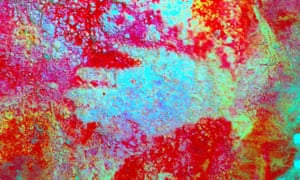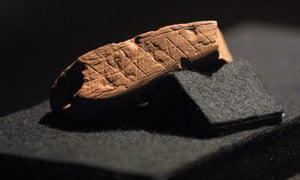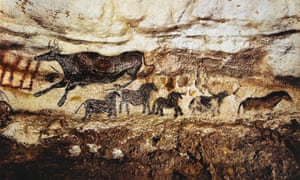https://www.theguardian.com/artanddesign/2018/feb/23/neanderthals-cave-art-spain-astounding-discovery-humbles-every-human
So Neanderthals made abstract art? This astounding discovery humbles every human
Scientists say cave paintings in Spain, thought to have been by our
ancestors, were actually by Neanderthals. So did they teach us
everything we know?

If you go to the painted caves of Spain and France, crawl through narrow passages and keep your balance on slippery rock floors, you reach the hidden places where ice age hunters made their marks tens of thousands of years ago. Nothing seems more startling than the way they placed hands against the cold rock and blew red ochre out of their mouths to leave fiery images. Of what though?
Up to now we called it the human presence. “The print of the hand says, ‘This is my mark. This is man’,” declared the scientist Jacob Bronowski when he visited caves in northern Spain in his classic TV series The Ascent of Man. Simon Schama visits those same caves in the BBC’s new epic series Civilisations and raves about those same handprints. For what could communicate the curiosity, self-assertion, intelligence, and above all self-consciousness of our unique species Homo sapiens, more clearly that this desire to literally leave our mark?
Except it is not unique to Homo sapiens at all. The potentially epoch-making announcement in the journal Science this week of a new dating for art in some of Spain’s painted caves includes the astounding discovery that a stencilled hand in Maltravieso cave is at least 66,700 years old – a date reached by testing the calcite deposits that have encrusted it over the millennia.
That is long before modern humans are known to have reached Europe on their migration out of Africa. It is also more than 25,000 years before the first paintings made by Homo sapiens in Europe were created at Chauvet in France. The Maltravieso hand is not human, at least not Homo sapiens. It has to be that of a Neanderthal, the early species that hunted the big beasts of ice age Europe before our lot came along, only to mysteriously vanish about 40,000 years ago, soon after our arrival.
Evolutionary timeline
This, however, does not make Neanderthals the “first artists”. That is to misunderstand early art. Cave paintings are not the oldest examples of symbolic art-making. A piece of red ochre carved with zigzag lines found at Blombos cave in South Africa has been dated to about 100,000 years ago. That’s the work of Homo sapiens. Stringer, however, points me to similar zigzag markings on a shell found in Indonesia that was made 500,000 years ago. This piece is apparently the work of another early human species, Homo erectus. So if anyone deserves to be called the first artist, it’s neither us nor the Neanderthals but Homo erectus.

A century ago, cave art was still barely accepted as being genuine. When Marcelino Sanz de Sautuola claimed in 1880 that paintings in Altamira cave in Spain were prehistoric, he was mocked and reviled as a faker. Gradually their antiquity was recognised but it was only when tremendous depictions of animals were found at Lascaux in France in 1940 that cave art exploded into modern culture. Today, it is at the heart of thinking about human evolution because it seems to illuminate the birth of the complex cathedral of the modern mind.

Now that all has to be rethought. “There must be something that’s different about modern humans,” says Stringer. “But it isn’t cave art.”
Let’s be clear. To make art is a massive thing. It opens the way, in modern human history, to everything from writing to computers. No living ape has made any real art like the images now attributed to Neanderthals. Zoologist Desmond Morris tried to teach Congo the chimpanzee to paint but its paintings “were nothing like this”, says Stringer.
On the other hand they are not much like Leonardo da Vinci either. “I don’t think there’s any evidence of representational art,” says Stringer. For me, that leaves a massive lifeline for the image of Homo sapiens as a uniquely brilliant creature.
When you see cave art for real – I’ve done so at Peche Merle and Cougnac in the Lot region and Niaux in the Pyrenees – there are two, perhaps three, types. There are many kinds of enigmatic abstract marks from dots to squiggles. There are those haunting “human” hands. And then there are the incredibly lifelike portrayals of mammoths and horses, bison and lions that most laypeople mean when we say “cave art”.
It seems very possible that Neanderthals actually taught Homo sapiens to paint in caves. However, there’s no evidence – yet – that they painted realistically. Could it just be that our relativism about what art is blinds us to the really amazing thing – the skill and perception of the paintings made by Homo sapiens?
If so, sceptics wanting to be rude about modern art don’t have to bring their kids into it any more. Abstract painting? My Neanderthal great great grandad could do that!
But here’s the thing. That Neanderthal hand is the first evidence ever found of another species showing cultural self-consciousness. It’s not so very far from a hand print to a self-portrait to a diary to a novel. This discovery dethrones the modern human mind. It also means that if, as well as interbreeding with Neanderthals and sharing artistic ideas with them, the first groups of Homo sapiens to enter Europe massacred them and helped make them extinct, it was our fellow thinking beings we were killing. Not just another extinction, but the first genocide.
THE GUARDIAN, Fri 23 Feb 2018
Aucun commentaire:
Enregistrer un commentaire